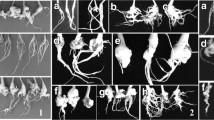Abstract
-
1.
Clubroot is the main disease of fodder turnips in the Netherlands. Growing resistant varieties is the only practical means of control.
-
2.
Sowing seeds in the first half of July is more efficient for selection for clubroot resistance than sowing in the normal period, early in August.
-
3.
Artificial infestation of a field soil may have advantages over a naturally infested field in selecting for resistance. “Furrow infestation” i.e. putting soil from heavily diseased farm fields into the furrows before sowing the turnips, seems a practicable method.
-
4.
Ten strains of Plasmodiophora brassicae were distinguished in the Netherlands and Belgium on the basis of the infection spectrum in a large set of differential hosts. Seven of them originate from farm fields where turnips are frequently grown. Each strain represents a group of clubroot isolates with similar infection spectra.
-
5.
Turnip varieties included in the 39 th Dutch Descriptive List of Varieties of Field Crops (1964) can be divided into three main groups based on their reaction to clubroot strains: 1) the V-group, comprising varieties which are very susceptible on nearly all diseased fields, 2) the M-group, varieties which are fairly resistant on most infested fields, and 3) the E-group, varieties which are fairly to very resistant on nearly all infested fields in the Netherlands; however, they are just as susceptible as the V-and M-group on a number of fields in Belgium. In addition a fourth group may be distinguished, viz. the L-group, comprising some varieties not mentioned in the “List”. These are moderately resistant on all clubroot fields in the Netherlands.
-
6.
Races of the fungus which are aggressive to the M-group apparently have been prevalent in certain clubroot fields for many years. In other fields these races gradually increase during some years when varieties of the M-group are grown. A mixture of different races is likely to occur in every infested field. Each of the above mentioned strains also has to be regarded as a mixture of races.
-
7.
Turnip varieties found resistant abroad usually turn out to be susceptible in the Netherlands. Only some Belgian varieties proved to be very resistant in our country. A few varieties which are susceptible in the Netherlands were found to be very resistant in some other countries. Clubroot races occurring in turnip fields in foreign countries, therefore, generally appear to be different from those found in the Netherlands.
Similar content being viewed by others
References
Ayers, G. W.,-1957. Races of Plasmodiophora brassicae. Canad. J. Bot. 35: 923–932.
Ayers, G. W. & Lelacheur, K. E.,-1962. Pathogenic specificity in races of Plasmodiophora brassicae. Proc. Canad. Phytopath. Soc. 29: 12. Ref. Plant Breeding Abstr. 33, 1963: 369.
Bochow, H.,-1962. Untersuchungen über die physiologische Spezialisierung der Plasmodiophora brassicae in der D.D.R. Nachr. Bl. dtsch. Pfl. Sch. Dienst (Berlin) NF 16: 126–130.
Colhoun, J.,-1953. A study of the epidemiology of clubroot disease of Brassicae. Ann. appl. Biol. 40: 262–283.
Colhoun, J.,-1958. Club root disease of crucifers caused by Plasmodiophora brassicae. A monography. Commonwealth Mycological Institute, Kew.
Gäumann, E.,-1951. Pflanzliche Infektionslehre. 2. Aufl. Birkhäuser, Basel: 264.
Gray, E. G.,-1959. Turnip varieties resistant to finger-and-toe disease (club-root). Scot. Agric., Spring 1959: 3 pp.
Honig, F.,-1931. Der Kohlkropferreger Plasmodiophora brassicae. Gartenbauwiss. 5: 116–225.
s'Jacob, J. C.,-1951, 1952, 1953, 1954, 1955. Knolvoet. In: Jaarverslagen Instituut voor Plantenziektenkundig Onderzoek, Wageningen.
Kole, A. P. & Gielink, A. J.,-1962. Electron microscope observations on the resting-spore germination of Plasmodiophora brassicae. Proc. Kon. Nederl. Adad. Wet. C 65: 117–121.
Kole, A. P. & Philipsen, P. J. J.,-1956. Fysiologische specialisatie bij Plasmodiophora brassicae. Tijdschr. Pl. Ziekt. 62: 261–265.
Lamberts, H.,-1958. Enkele aspekten bij de veredeling van stoppelknollen. Meded. St. Plant. Vered. (S.V.P.), Wageningen, 20: 97–103.
MacFarlane, I.,-1955. Variation in Plasmodiophora brassicae. Ann. appl. Biol. 43: 297–306.
Meyer, J. K.,-1952. Praktijkervaringen met de bestrijding van knolvoet. Maandbl. Landbouwvoorlichtingsdienst 9: 311–314.
Nieuwhof, M. & Wiering, D.,-1961. Testing cabbage plants for club root resistance. Euphytica 10: 191–200.
Rassenlijst voor Landbouwgewassen, Beschrijvende,-1964. Wageningen 39: 36–44.
Ross, H.,-1959. Grundlagen der Resistenzzüchtung. In: 30 Jahre Züchtungsforschung. G. Fischer, Stuttgart: 113.
Rousseau, M.,-1958. “Waaslander” R.V.P. en “Meetjeslander” R.V.P. Landbouw-Tijdschrift (Brussel) 11: 1704–1706.
Rousseau, M.,-1962. Opzoekingen in verband met knolvoetresistentie bij stoppelrapen. Landbouw-Tijdschrift (Brussel) 15: 775–787.
Scheijgrond, W. & Vos, H.,-1954. Investigation on the susceptibility to clubroot. Euphytica 3: 125–139.
Seaman, W. L.,-1960. Variability in pathogenicity among isolates of Plasmodiophora brassicae. Thesis Univ. Wisc., Univ. Microfilms, Inc., Ann. Arbor, Mich., U.S.A.
Slijcken, A.van,-1949. Proeven op knolvoetresistentie bij rapen. Landbouw-Tijdschrift (Brussel) 2: 425–438.
Tjallingii, F.,-1956, 1957, 1961. Knolvoet. In: Jaarverslagen Instituut v. Plantenziektenkundig Onderzoek, Wageningen.
Tjallingii, F.,-1960. Physiologische Spezialisierung bei Plasmodiophora brassicae und die Züchtung hernieresistenter Wasserrübensorten. Tagungsberichte Deutsche Akad. Landwirtsch. Wiss. Berlin 32: 145–154.
Walker, J. C.,-1939. Resistance to clubroot in varieties of turnip and rutabaga. J. agric. Res. 59: 815–827.
Williams, P. H. & Walker, J. C.,-1963. Races of clubroot in North America. Plant Disease Reporter 47: 608–611.
Wrr, F. & van de Weg, M.,-1964. Clubroot-resistance in turnips (Brassica campestris L.) I. Physiologic races of the parasite and their identification in mixtures. Euphytica 13: 9–18.
Author information
Authors and Affiliations
Rights and permissions
About this article
Cite this article
Tjallingii, F. Testing clubroot-resistance of turnips in the netherlands and the physiologic specialization of plasmodiophora brassicae. Euphytica 14, 1–22 (1965). https://doi.org/10.1007/BF00032809
Received:
Issue Date:
DOI: https://doi.org/10.1007/BF00032809




